现在完成时态讲练完整版学案
- 格式:doc
- 大小:111.50 KB
- 文档页数:8
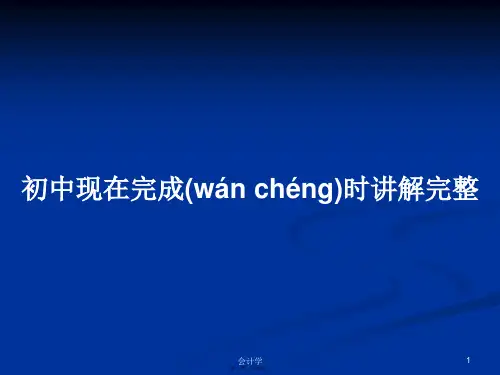
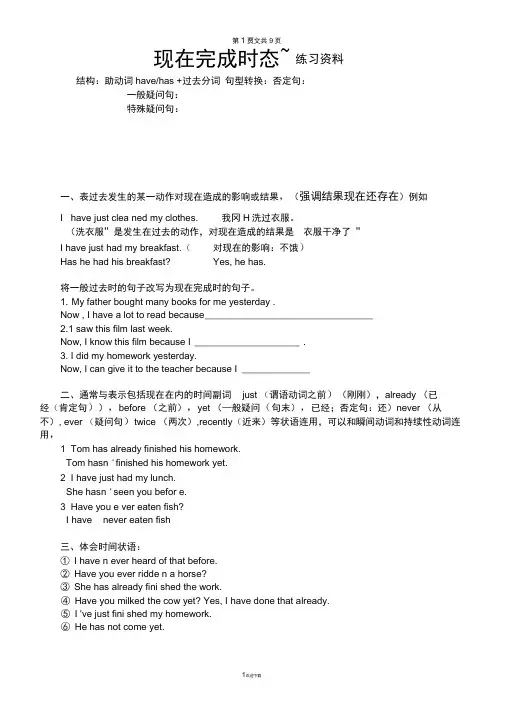
第1贾文共9页现在完成时态~练习资料结构:助动词have/has +过去分词句型转换:否定句:一般疑问句:特殊疑问句:一、表过去发生的某一动作对现在造成的影响或结果,(强调结果现在还存在)例如I have just clea ned my clothes. 我冈H洗过衣服。
(洗衣服”是发生在过去的动作,对现在造成的结果是衣服干净了”I have just had my breakfast.(对现在的影响:不饿)Has he had his breakfast? Yes, he has.将一般过去时的句子改写为现在完成时的句子。
1. My father bought many books for me yesterday .Now , I have a lot to read because ________________________________2.1 saw this film last week.Now, I know this film because I ____________________ .3. I did my homework yesterday.Now, I can give it to the teacher because I _____________二、通常与表示包括现在在内的时间副词just (谓语动词之前)(刚刚),already (已经(肯定句)),before (之前),yet (—般疑问(句末),已经;否定句:还)never (从不), ever (疑问句)twice (两次),recently(近来)等状语连用,可以和瞬间动词和持续性动词连用,1 Tom has already finished his homework.Tom hasn 'finished his homework yet.2 I have just had my lunch.She hasn 'seen you befor e.3 Have you e ver eaten fish?I have never eaten fish三、体会时间状语:①I have n ever heard of that before.②Have you ever ridde n a horse?③She has already fini shed the work.④Have you milked the cow yet? Yes, I have done that already.⑤I 've just fini shed my homework.⑥He has not come yet.五、翻译句子: 1你已经问过这个问题两边了,别再烦我了。
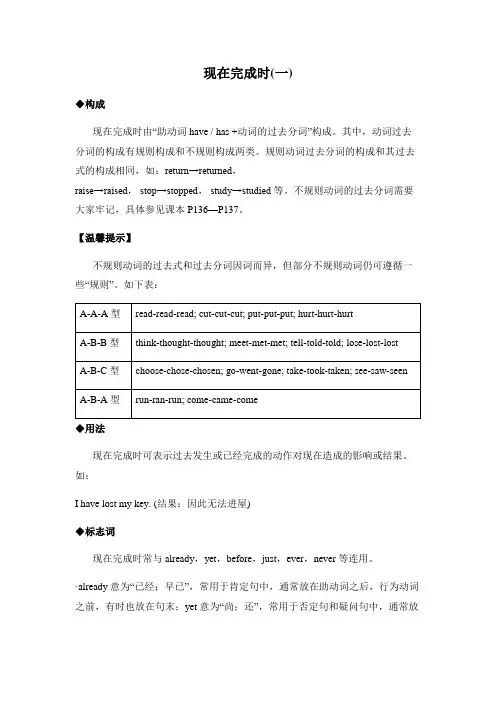
现在完成时(一)◆构成现在完成时由“助动词have / has +动词的过去分词”构成。
其中,动词过去分词的构成有规则构成和不规则构成两类。
规则动词过去分词的构成和其过去式的构成相同,如:return→returned,raise→raised,stop→stopped,study→studied等。
不规则动词的过去分词需要大家牢记,具体参见课本P136—P137。
【温馨提示】不规则动词的过去式和过去分词因词而异,但部分不规则动词仍可遵循一些“规则”。
如下表:◆用法现在完成时可表示过去发生或已经完成的动作对现在造成的影响或结果。
如:I have lost my key. (结果:因此无法进屋)◆标志词现在完成时常与already,yet,before,just,ever,never等连用。
·already意为“已经;早已”,常用于肯定句中,通常放在助动词之后,行为动词之前,有时也放在句末;yet意为“尚;还”,常用于否定句和疑问句中,通常放在句末。
含有already的肯定句变否定句或疑问句时,要将already变为yet,并置于句末。
如:The rain has already stopped.→The rain hasn’t stopped yet.→Has the rain stopped yet?·before意为“以前”,常放在句末。
如:They have never visited the fire station before.·just意为“刚刚;刚才”,ever意为“曾;曾经”,never意为“从来没有”,它们通常放在助动词之后,行为动词之前。
如:David has just gone.Have you ever talked to him about it?I have never broken my word.◆各种句式结构·肯定句:主语+have / has+动词的过去分词(+其他).如:I have washed my car.·否定句:主语+haven’t / hasn’t+动词的过去分词(+其他). 如:I haven’t washed my car.·一般疑问句:Have / Has+主语+动词的过去分词(+其他)?肯定回答:Yes, 主语(人称代词)+have / has.否定回答:No, 主语(人称代词)+haven’t / hasn’t.如:—Have you washed your car?—Yes, I have. / No, I haven’t.现在完成时(二)have / has been to & have / has gone to◆“主语+have / has been to+地点名词”表示“某人曾经去过某地”,暗含的意思是某人现在已经回来了,不在那里了。
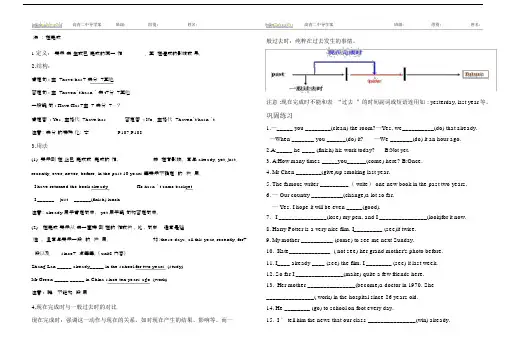
高青二中导学案班级:组别:姓名:法:在完成1.定义:表示去生或已完成的某一作,其在造成的影响或果。
2.结构:肯定句 : 主 +have/has+去分 +其他否定句 : 主 +haven’t/hasn ’ 去t+分 +其他一般疑句 : Have/Has+主 +去分 + ⋯?肯定答 : Yes, 主格代 +have/has.否定答: No,主格代+haven’t/hasn’t.注意:去分的特殊化:本P107,P1083.用法(1) 表示到在止已完成或完成的作,并在有影响。
常与already, yet, just, recently, ever, never, before, in the past 10 years等表示不确定的状用。
I have returned the book already.He hasn ’ t come backyet.I ______ just ______(finish) lunch.注意: already 用于肯定句中, yet 用于疑句和否定句中。
(2)在完成表示从去一直持到在的作或状。
此,句中通常是延性,且常与表示一段的状用。
如:these days, all this year, recently, for+ 段以及since+点等等。
( unit8 内容)Zhang Lan _____ already_____ in the school for two years. (study)Mr Green _____ _____ in China since ten years ago. (work)注意 : 瞬不能和段用.4.现在完成时与一般过去时的对比现在完成时:强调这一动作与现在的关系,如对现在产生的结果、影响等。
而一高青二中导学案班级:组别:姓名:般过去时:纯粹在过去发生的事情。
注意 :现在完成时不能和表“过去”的时间副词或短语连用如: yesterday, last year等。
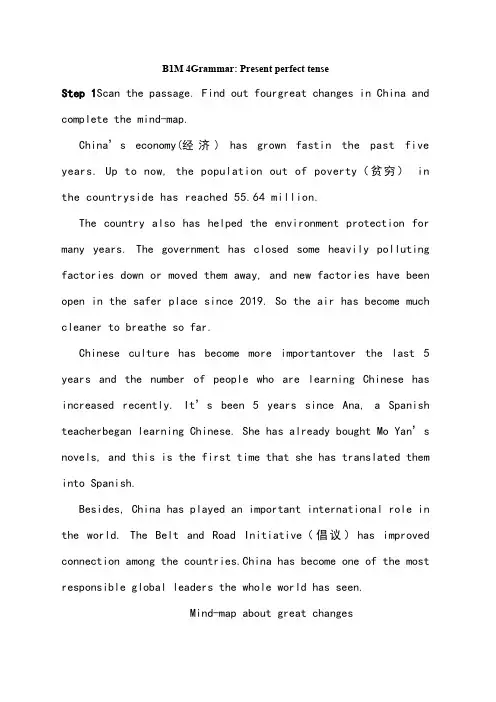
B1M 4Grammar: Present perfect tenseStep 1Scan the passage. Find out fourgreat changes in China and complete the mind-map.China’s economy(经济) has grown fastin the past five years. Up to now, the population out of poverty(贫穷)in the countryside has reached 55.64 million.The country also has helped the environment protection for many years. The government has closed some heavily polluting factories down or moved them away, and new factories have been open in the safer place since 2019. So the air has become much cleaner to breathe so far.Chinese culture has become more importantover the last 5 years and the number of people who are learning Chinese has increased recently. It’s been 5 years since Ana, a Spanish teacherbegan learning Chinese. She has already bought Mo Yan’s novels, and this is the first time that she has translated them into Spanish.Besides, China has played an important international role in the world. The Belt and Road Initiative(倡议)has improved connection among the countries.China has become one of the most responsible global leaders the whole world has seen.Mind-map about great changesStep 2Read the passage carefully. Underline present perfect tense, circle time adverbials, and then summarize the usage. Tense Present _______ tense(现在完成时态)Structure(结构)__________Time adverbials (时间状语)____(2019); _______ (many years); in the past five years,__________,___________,__________,Sentencepatterns(句型)Function To describe an action that_____ in the pastand has some influence onthe_____situation; or may_______in thefutureStep 3Join the words or phrases in the box into sentences about the changes in means of transportation with present perfect tense.it’s been…since sb. did/complete/ metro line_______________________________________________________________ _____the bullet train/ one of the mostconvenient…/take /so far_______________________________________________________________ _____the first time that…/use/ the shared cars_______________________________________________________________ _____the shared bikes/ appear/ for about 4 years_______________________________________________________________ _____Step 4 Expand your sentences into a short passage to introduce these changes in Chengdu to Ana._______________________________________________________________ _______________________________________________________________ _______________________________________________________________ _______________________________________________________________ ____________________HomeworkPolish your writing and share it with your classmates.。
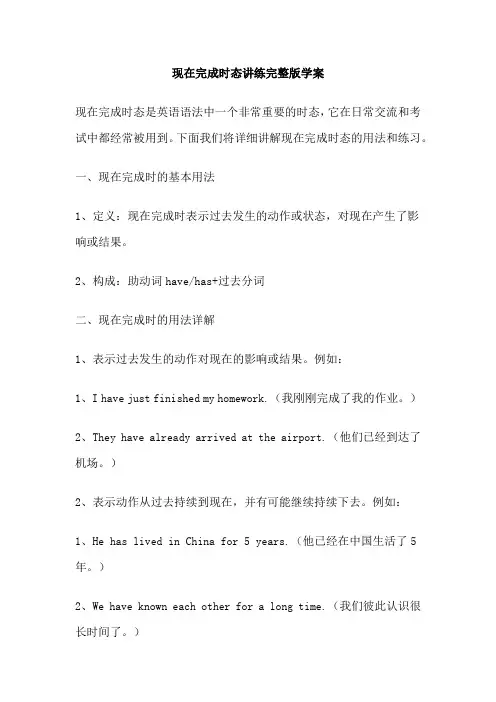
现在完成时态讲练完整版学案现在完成时态是英语语法中一个非常重要的时态,它在日常交流和考试中都经常被用到。
下面我们将详细讲解现在完成时态的用法和练习。
一、现在完成时的基本用法1、定义:现在完成时表示过去发生的动作或状态,对现在产生了影响或结果。
2、构成:助动词have/has+过去分词二、现在完成时的用法详解1、表示过去发生的动作对现在的影响或结果。
例如:1、I have just finished my homework.(我刚刚完成了我的作业。
)2、They have already arrived at the airport.(他们已经到达了机场。
)2、表示动作从过去持续到现在,并有可能继续持续下去。
例如:1、He has lived in China for 5 years.(他已经在中国生活了5年。
)2、We have known each other for a long time.(我们彼此认识很长时间了。
)3、表示过去的动作或状态在过去的一段时间内持续进行。
例如:1、They have been studying together for 2 years.(他们一起学习了2年。
)2、I have been waiting for you for a long time.(我已经等了你很长时间了。
)三、现在完成时的练习1、基础练习:根据所给的时间状语,用现在完成时态造句。
1、已经:They have already finished the work.2、最近:I have just received a letter from my friend.3、一段时间:We have lived here for 10 years.4、从来没有:I have never seen such a beautiful sunset.2、提高练习:根据所给情景,用现在完成时态编写一段对话。
情景:大家和朋友一起去旅行,途中经过一家美食店,大家决定尝试一下当地特色美食。
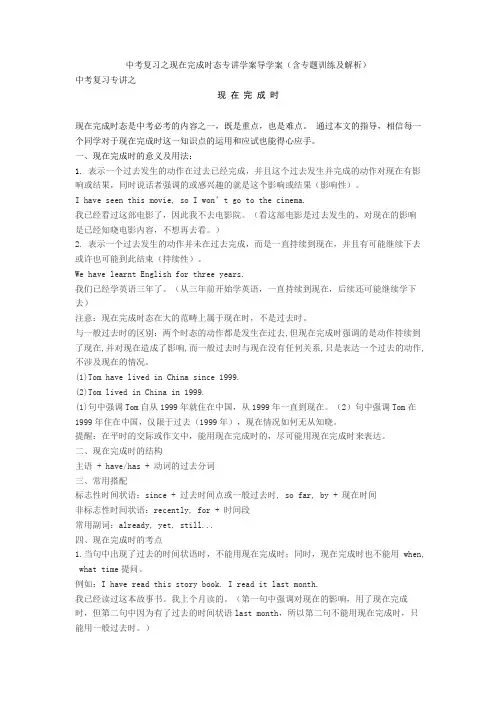
中考复习之现在完成时态专讲学案导学案(含专题训练及解析)中考复习专讲之现在完成时现在完成时态是中考必考的内容之一,既是重点,也是难点。
通过本文的指导,相信每一个同学对于现在完成时这一知识点的运用和应试也能得心应手。
一、现在完成时的意义及用法:1.表示一个过去发生的动作在过去已经完成,并且这个过去发生并完成的动作对现在有影响或结果,同时说话者强调的或感兴趣的就是这个影响或结果(影响性)。
I have seen this movie, so I won’t go to the cinema.我已经看过这部电影了,因此我不去电影院。
(看这部电影是过去发生的,对现在的影响是已经知晓电影内容,不想再去看。
)2. 表示一个过去发生的动作并未在过去完成,而是一直持续到现在,并且有可能继续下去或许也可能到此结束(持续性)。
We have learnt English for three years.我们已经学英语三年了。
(从三年前开始学英语,一直持续到现在,后续还可能继续学下去)注意:现在完成时态在大的范畴上属于现在时,不是过去时。
与一般过去时的区别:两个时态的动作都是发生在过去,但现在完成时强调的是动作持续到了现在,并对现在造成了影响,而一般过去时与现在没有任何关系,只是表达一个过去的动作,不涉及现在的情况。
(1)Tom have lived in China since 1999.(2)Tom lived in China in 1999.(1)句中强调Tom自从1999年就住在中国,从1999年一直到现在。
(2)句中强调Tom在1999年住在中国,仅限于过去(1999年),现在情况如何无从知晓。
提醒:在平时的交际或作文中,能用现在完成时的,尽可能用现在完成时来表达。
二、现在完成时的结构主语 + have/has + 动词的过去分词三、常用搭配标志性时间状语:since + 过去时间点或一般过去时, so far, by + 现在时间非标志性时间状语:recently, for + 时间段常用副词:already, yet, still...四、现在完成时的考点1.当句中出现了过去的时间状语时,不能用现在完成时;同时,现在完成时也不能用when, what time提问。
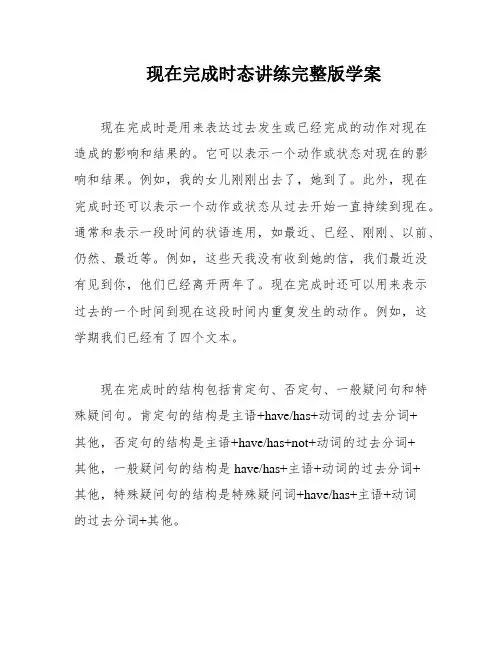
现在完成时态讲练完整版学案现在完成时是用来表达过去发生或已经完成的动作对现在造成的影响和结果的。
它可以表示一个动作或状态对现在的影响和结果。
例如,我的女儿刚刚出去了,她到了。
此外,现在完成时还可以表示一个动作或状态从过去开始一直持续到现在。
通常和表示一段时间的状语连用,如最近、已经、刚刚、以前、仍然、最近等。
例如,这些天我没有收到她的信,我们最近没有见到你,他们已经离开两年了。
现在完成时还可以用来表示过去的一个时间到现在这段时间内重复发生的动作。
例如,这学期我们已经有了四个文本。
现在完成时的结构包括肯定句、否定句、一般疑问句和特殊疑问句。
肯定句的结构是主语+have/has+动词的过去分词+其他,否定句的结构是主语+have/has+not+动词的过去分词+其他,一般疑问句的结构是have/has+主语+动词的过去分词+其他,特殊疑问句的结构是特殊疑问词+have/has+主语+动词的过去分词+其他。
现在完成时常常和时间状语或标志词连用。
这些时间状语或标志词包括已经、尚未、刚刚、以前、最近、仍然、最近、曾经、从未、两次、长达、自从……以来、到目前为止、多长时间等。
需要注意的是,现在完成时不能单独与准确时间连用,除非与for、since连用。
He says he has been to the USA three times。
This XXX.So far is often used to indicate that an n or state has happened up until now。
For example。
"He has got to Beijing so far" means that he has arrived in Beijing up until this point in time。
Another example is "She has passed the exam so far," which means that she has already passed the exam up until this point.When a past n has continued up until the present and may continue in the future。
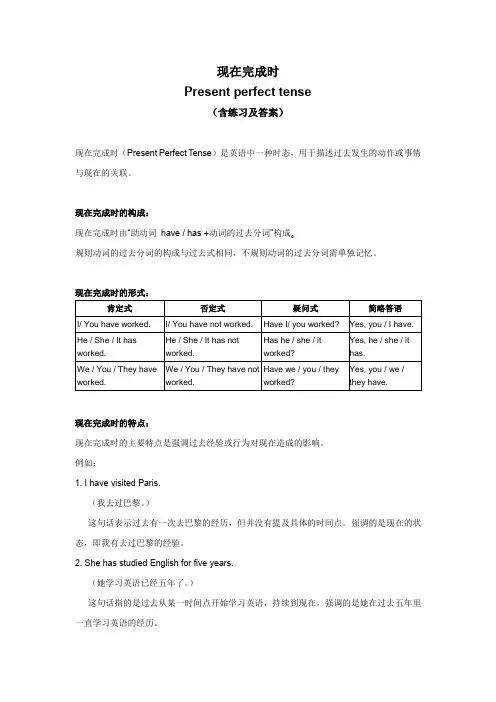
现在完成时Present perfect tense(含练习及答案)现在完成时(Present Perfect Tense)是英语中一种时态,用于描述过去发生的动作或事情与现在的关联。
现在完成时的构成:现在完成时由“助动词have / has +动词的过去分词”构成。规则动词的过去分词的构成与过去式相同,不规则动词的过去分词需单独记忆。
现在完成时的形式:肯定式否定式疑问式简略答语I/ You have worked. I/ You have not worked. Have I/ you worked? Yes, you / I have.He / She / It has worked. He / She / It has notworked.Has he / she / itworked?Yes, he / she / ithas.We / You / They have worked. We / You / They have notworked.Have we / you / theyworked?Yes, you / we /they have.现在完成时的特点:现在完成时的主要特点是强调过去经验或行为对现在造成的影响。
例如:1. I have visited Paris.(我去过巴黎。
)这句话表示过去有一次去巴黎的经历,但并没有提及具体的时间点。
强调的是现在的状态,即我有去过巴黎的经验。
2. She has studied English for five years.(她学习英语已经五年了。
)这句话指的是过去从某一时间点开始学习英语,持续到现在。
强调的是她在过去五年里一直学习英语的经历。
3. They have finished their homework.(他们完成了作业。
)这句话表示过去发生的动作,即他们已经完成了作业,且与现在有关联,即作业的完成状态。
4. We haven't seen each other for a long time.(我们已经很久没见面了。
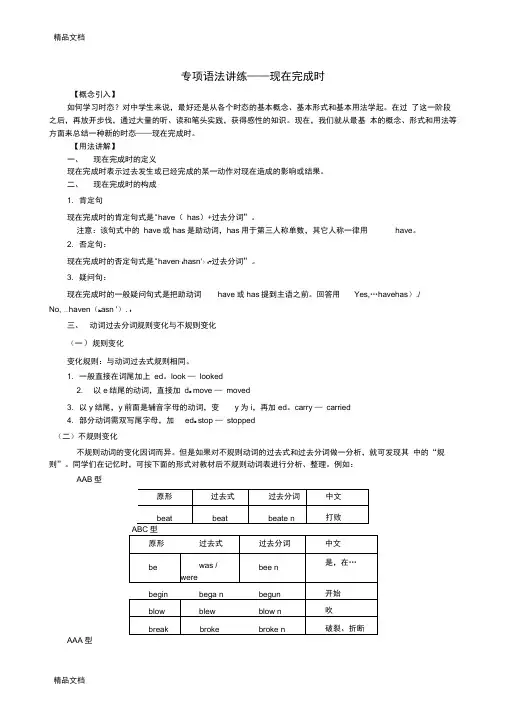
专项语法讲练——现在完成时【概念引入】如何学习时态?对中学生来说,最好还是从各个时态的基本概念、基本形式和基本用法学起。
在过了这一阶段之后,再放开步伐,通过大量的听、读和笔头实践,获得感性的知识。
现在,我们就从最基本的概念、形式和用法等方面来总结一种新的时态——现在完成时。
【用法讲解】一、现在完成时的定义现在完成时表示过去发生或已经完成的某一动作对现在造成的影响或结果。
二、现在完成时的构成1. 肯定句现在完成时的肯定句式是"have(has)+过去分词”。
注意:该句式中的have或has是助动词,has用于第三人称单数,其它人称一律用have。
2. 否定句:现在完成时的否定句式是"haven' t hasn')t+过去分词”。
3. 疑问句:现在完成时的一般疑问句式是把助动词have或has提到主语之前。
回答用Yes,…havehas)./No, …haven(h asn '). t三、动词过去分词规则变化与不规则变化(一)规则变化变化规则:与动词过去式规则相同。
1. 一般直接在词尾加上ed。
look —looked2. 以e结尾的动词,直接加d o move —moved3. 以y结尾,y前面是辅音字母的动词,变y为i,再加ed。
carry —carried4. 部分动词需双写尾字母,加ed o stop —stopped(二)不规则变化不规则动词的变化因词而异。
但是如果对不规则动词的过去式和过去分词做一分析,就可发现其中的“规则”。
同学们在记忆时,可按下面的形式对教材后不规则动词表进行分析、整理。
例如:AAB型AAA型ABA型ABB型四、现在完成时的用法现在完成时表示过去某时发生的行为对主语目前产生的影响。
即用过去发生的某个行为来说明现在的某种情况。
例如:We are good frie nds.(现在的情况)我们是好朋友。
I knew him in 1997.(过去的动作)我1997年认识了他。
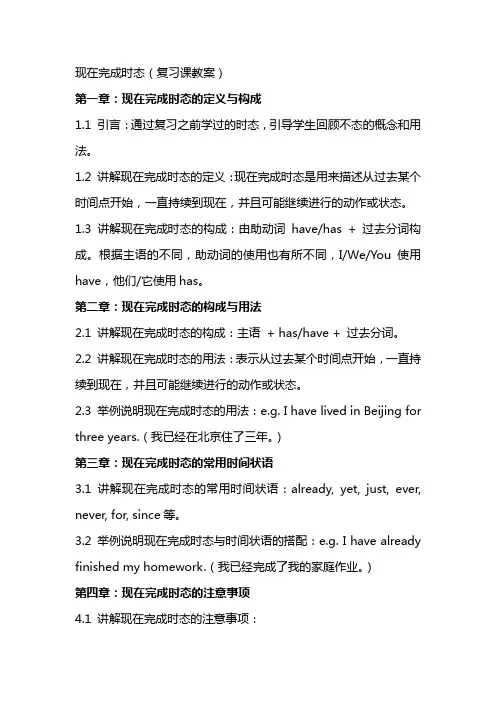
现在完成时态(复习课教案)第一章:现在完成时态的定义与构成1.1 引言:通过复习之前学过的时态,引导学生回顾不态的概念和用法。
1.2 讲解现在完成时态的定义:现在完成时态是用来描述从过去某个时间点开始,一直持续到现在,并且可能继续进行的动作或状态。
1.3 讲解现在完成时态的构成:由助动词have/has + 过去分词构成。
根据主语的不同,助动词的使用也有所不同,I/We/You使用have,他们/它使用has。
第二章:现在完成时态的构成与用法2.1 讲解现在完成时态的构成:主语+ has/have + 过去分词。
2.2 讲解现在完成时态的用法:表示从过去某个时间点开始,一直持续到现在,并且可能继续进行的动作或状态。
2.3 举例说明现在完成时态的用法:e.g. I have lived in Beijing for three years.(我已经在北京住了三年。
)第三章:现在完成时态的常用时间状语3.1 讲解现在完成时态的常用时间状语:already, yet, just, ever, never, for, since等。
3.2 举例说明现在完成时态与时间状语的搭配:e.g. I have already finished my homework.(我已经完成了我的家庭作业。
)第四章:现在完成时态的注意事项4.1 讲解现在完成时态的注意事项:a. 现在完成时态不能与具体的时间状语连用,如今天、昨天、明天等。
b. 现在完成时态不能与表示过去的过去的时间状语连用,如last week、two days ago等。
c. 现在完成时态不能与表示将来的时间状语连用,如next week、tomorrow等。
4.2 进行相关练习,巩固现在完成时态的用法。
第五章:现在完成时态的综合练习5.1 设计综合练习题,包括选择题、填空题、改错题等,考察学生对现在完成时态的掌握程度。
5.2 学生互相练习,教师进行点评和讲解。
现在完成时态(复习课教案)第一章:现在完成时态的定义与用法1.1 引入:通过一个日常对话,引导学生思考过去发生的事情对现在的影响。
1.2 现在完成时态的定义:强调过去发生的动作或状态对现在的影响或结果。
1.3 现在完成时态的结构:主语+ have/has + 过去分词。
1.4 现在完成时态的用法:描述过去的经历、已经完成的动作、现阶段的状态等。
1.5 练习:完成下列句子,使用现在完成时态。
第二章:现在完成时态的构成2.1 引入:通过图片和情境,引导学生理解现在完成时态的构成。
2.2 现在完成时态的构成:助动词have/has + 过去分词。
2.3 练习:填空,选择合适的助动词和过去分词,构成现在完成时态的句子。
第三章:现在完成时态的关键时间状语3.1 引入:通过情境和例句,引导学生理解现在完成时态的关键时间状语。
3.2 常见的时间状语:already, yet, just, ever, never, for, since等。
3.3 练习:根据给定情境,选择合适的时间状语,完成句子。
第四章:现在完成时态的否定句与疑问句4.1 引入:通过例句,引导学生理解现在完成时态的否定句和疑问句的构成。
4.2 否定句的构成:主语+ have/has not + 过去分词。
4.3 疑问句的构成:Have/Has + 主语+ 过去分词?4.4 练习:完成下列句子,分别是现在完成时态的否定句和疑问句。
第五章:现在完成时态的综合练习5.1 引入:通过情境和例句,引导学生综合运用现在完成时态。
5.2 练习:根据给定情境,完成一段对话,运用现在完成时态描述过去发生的动作对现在的影响。
第六章:现在完成时态与一般过去时的区别6.1 引入:通过一个故事情境,引导学生思考过去发生的事情对现在的影响。
6.2 现在完成时态与一般过去时的区别:现在完成时态强调过去发生的动作或状态对现在的影响或结果。
一般过去时态仅用来描述过去发生的动作或状态,不强调对现在的影响。
现在完成时态讲解与练习一、概念:1)现在完成时通常表示过去发生或已经完成的某一动作对现在造成的影响和结果。
说话人强调的是该动作或状态对现在的结果或影响。
My daughter has just gone out. 我女儿刚出去。
She has arrived. 她到了。
2)表示开始于过去并持续到现在的动作或状态,往往和包括现在在内的表示一段时间的状语连用,如recently, already, just, lately, for 等⋯。
, 如sin:ce ⋯,yetI haven ' t hearrodm f her these days. 这些日子我没有收到她的信。
We haven ' t seen you recently.最近我们没有见到你。
They have been away for two years. 他们离开已经两年了。
3)现在完成时还可以用来表示过去的一个时间到现在这段时间内重复发生的动作.We have had four texts this term.二、结构:1.肯定句:主语+have/has+动词的过去分词+其他2.否定句:主语+have/has+not+动词的过去分词+其他3.一般疑问句:have/has+主语+动词的过去分词+其他Yes, 主语+have/has. No , 主语+have/has+not4.特殊疑问句:特殊疑问词+have/has+主语+动词的过去分词+其他三、常和现在完成时一起连用的时间状语或标志词:【注意】:现在完成时不能单独与准确时间连用,(如表示过去的时间状语)如y esterday(morning 、afternoon),last(morning 、afternoon)等,除非与for, since 连用.1.现在完成时往往同表示不确定的过去时间状语连用:如already(已经)(肯定), yet(尚,还)(否定,疑问), just(刚刚), before(以前), recently(最近), still (还,仍然), lately(最近),ever(曾), never (从不,未曾), twice(两次)(重复性时间),for+短时间(长达⋯⋯),since+点时间(自从⋯⋯以来),so far(到目前为止,迄今), how long (多长时间)提问的疑问句中He has already obtained a scholarship.I haven't seen much of him recently (lately).We have seen that film before.Have they found the missing child yet ?2.现在完成时常常与表示频度的时间状语连用,如ever, never, twice, several times(几次)等:Have you ever been to BeijingI have never heard Bunny say anything against her.I have used this pen only three times. It is still good.George has met that gentleman several times.3.现在完成时还往往可以同包括现在时间在内的时间状语连用,如up to these few days/weeks/months/years (直到⋯⋯), just, up to present(now)(到目前为止,迄今), so far 等:Peter has written six papers so far.Up to the present everything has been successful.【注意】:一)现在完成时的含义之一是过去完成的动作对现在仍有影响,用以下四大标志词可以表达这种含义◎ 以already, just 和yet 为标志already, just 和yet 表示到现在为止动作或状态已经、刚刚或还没有发生。
中考人教版初中英语语法---现在完成时教学案及练习同学英语学科核心素养培养与个性发展研究巩固练习用never,ever,already,before, just或yet填空。
1. I have __________seen him before, so I have no idea about him.2. Jack has __________finished his homework.3. --Have you _________seen the film? --No, I have ________seen it.4. ---Has the bus left _______? ---Yes, it has ________ left.5. Would you like to go to the zoo with me? Yes, but I have been there _________.用have gone to / have been to / have been in / went to 填空。
1. _____ you ever _____ Disneyland?2. How many times _____ you _____ Disneyland ?3. I _____ Nanjing since two years ago4. Mr. Li _____ Hong Kong. And he'll come back in two days.5. —How long _____ you _____ Disneyland ?—For three days. I __________ the theme park last Sunday.6. My father __________ Hong Kong two weeks ago.7. My father __________ Hong Kong in 2005.8. My father __________ Hong Kong since 2005.9. My father __________ Hong Kong twice.10. My father __________ Hong Kong and he hasn't come back yet.11. —Where's Lucy? —She has__________ to a restaurant for lunch.12. Have you __________ to this park before.13. I have__________ there only once this year.14. She has __________ to the shop to buy a notebook.15. You're late, Lao Wang has __________ to Guangzhou.选用for和since填空:1.We haven’t seen each other ______ a long time.2.His father has been in the Party ______ 10 years ago.3.The film has been on ______ 20 minutes.4.Mr Green has worked here ______ he came to China.5.His grandparents have been dead ______ several years.6. It’s five years _______ we met last time.一.单项选择1.I have been living here _____ 1999.A. forB. afterC. inD. since2._____ have you been playing the guitar? For 5 years.A. How soonB. How longC. How farD. How often3.______ may I keep these books? For two weeks.A. How oftenB. How farC. How longD. How soon4.______ have you been here? I’ve been here for months.A. How longB. How oftenC. How muchD. How many5. The boy ______TV all morning.A. has watchedB. had watchedC. has been watchingD. watched6. How long _____ you _____ stamps? Since two years ago.A. have, collectedB. did, collectC. have , been collectingD. are, collecting7.They are still working in the fields. They ______ for two hours.A. was workingB. has been workingC. workedD. are working8.He looks tired. Oh , he ____ for three hours.A. have been skatingB. have been skatedC. has been skatingD. has been skated9. He ______ it for two hours, and he is still watching now.A. has beenB. watchingC. has been watchingD. is watching10. The famous writer _____ one new book in the past two years.A. is writingB. was writingC. wroteD. has written11.Harry Potter is a very nice film . I_______ it twice.A. will seeB. have seenC. sawD. see12.His father ______ the Party since 1978.A. joinedB. has joinedC. was inD. has been in13.How long have you ____ here?—About two months.A. beenB. goneC. comeD. arrived14.Hurry up!The play _____ for ten minutes.A. has begunB. had begunC. has been onD. began15 It _____ ten years since he left the army.A. isB. hasC. willD. was16.My parents ______ Shandong for ten years.A. have been inB. have been toC. have gone toD. have been17.____has Mr White been a member of Greener China since he ____to China?A. How soon,comesB. How often,gotC. How long,cameD. How far,arrived18. His uncle ____ for more than 9 years.A. has come hereB. has started to workC. has lived thereD. has left the university19.Sarah has been sleeping ______ 2:00 pm.A. forB. atC. inD. since20.The students have cleaned the classroom,_____?A. so theyB. don‘t the yC. have theyD. haven’t they二.句型转换:1.I have been watching the football match for half an hour.(划线提问)_______ ________ _______ you been watching the football match?2.He has been studying Japanese for two years.(同义句转换)He has been studying Japanese ______ two years ______.3.We started the party two hours ago.(划线提问)______ _______ you ________ the party?4.The old man _____ last year.He __________________for a year. (die)(动词填空)5.Do you swim every day?(用for two hours 改写)_______ you ________ for two hours.6.Miss Gao left an hour ago. (同义句转换)Miss Gao ________ _______ ________ ________ an hour.7.Her mother has been a Party member for three years .(同义句)Her mother _______ the Party three years ________ .8.The Green Family moved to France two years ago. (同义句转换)_______ two years ________ the Green family moved to France.、一、英语阅读理解专项练习试卷1.阅读理解Jenny looked at the store window. There was nothing that she wanted more than a Happy Hannah doll. It was $29.95. Unluckily, Jenny didn't even have the 95 cents.As she crossed the street, she thought about doing her brother's housework, cleaning the floor, washing the dishes all month, but even then she would have only eleven dollars. Suddenly, something small and pink in the snow caught her eyes.Jenny walked over and picked it up from the snow. It was a beautiful wallet. She opened the wallet and found many dollars and a woman's driver's license in it. Jenny put the wallet into her bag quickly. She turned around and walked back.Jenny's heart beat(跳动) fast as she went into the store. She had long dreamed about this moment, but something didn't feel right. As she got to the Happy Hannah dolls, she pushed away her feelings. She grabbed(抓起) one and walked toward the checkout.As Jenny was waiting to pay, her mobile phone rang. It was her grandma. Jenny's heart was suddenly filled with love and warmth when she thought of her. She put the doll down and answered the phone.“Hi, Grandma? I'm going to be a little bit late tonight...Alright...I love you, too.” Jenny left the store and walked all the way to 301 West Street. The woman who answered the door looked sad.“Here, I found this in the snow,” Jenny said.“Oh, good God! This is the money for the orphanage(孤儿院)! Thank you!”After doing her brother's housework for three months, Jenny finally got a Happy Hannah doll. She was so happy because she could play with her doll and look her grandma in the eye.(1)What did Jenny find in the snow?A. A bag.B. A wallet.C. A doll.D. A mobile phone.(2)How did Jenny feel when she thought of her grandma?A. Moved.B. Surprised.C. Nervous.D. Warm.(3)Why did Jenny go to 301 West Street?A. To find a toy store.B. To visit the orphanage.C. To return the money.D. To look after the woman.(4)What did Jenny do to get the doll?A. She did her brother's housework for three months.B. She asked her grandma to buy it for her.C. She took some money from the woman.D. She cleaned the floor in the store for all month.(5)What do we know from the story?A. The girl is kind and never does wrong.B. The girl's grandma has a great influence on her.C. The woman is mean and never helps others.D. The girl didn't have a Happy Hannah doll in the end.【答案】(1)B(2)D(3)C(4)A(5)B【解析】【分析】本文叙述了有一次詹妮在雪地里捡起了一个钱包,她本想去拿着这钱去买一个自己喜欢的洋娃娃,可是当她想付钱的时候,她接到了祖母的电话,她想起来祖母,于是就放弃了用捡来的钱来买东西的想法,把钱包物归原主了,决定通过给她的弟弟做三个月的作业,最后得到了自己想要的洋娃娃。
外研版8下现在完成时态学案一、教学目标:1、初步认识、了解现在完成时2、初步记忆过去分词的构成3、初步运用现在完成时二、重难点:现在完成时的运用三、教学过程:Step one 课前延伸课前预习Module2 and 3的单词及P103的语法---现在完成时Step two 课内探究(一)自主学习预习现在完成时(二)讨论交流小组合作,讨论交流现在完成时的构成,时间标志,用法(三)精讲点拨1、构成:have/has+ pp (动词的过去分词)2、时间标志:常与already(已经), yet(已经), just(刚刚),before(以前),ever(曾经)等词连用.注:already: 常用于肯定句中.yet: 常用于否定句,疑问句尾.3、用法:1)动作发生在过去;2)、且对现在有一定的影响。
Eg No1 Someone has broken the window. (窗户现在是坏的) No2 I have already lost the key. (我现在没有钥匙)No3 I haven’t read that book yet . (不了解书的内容)No4 I have just cleaned my hands. (手是干净的)No5 We have seen him before.(四)、训练巩固1、按要求改变句子。
1). She has done her homework. (改否定句)2). She has already told us the news. (改否定句)3). The rain has already stopped. (改一般疑问句)4). He has lived in ShangHai. (划线提问)5). They have bought a new car, ______ ________? (反义疑问句) 2、翻译下列句子.1)你已经找到你的书了吗? (find-found)2)他们在这个城市建了许多房子. (build-built)3)Judy还没到达. (arrive-arrived)4)你吃过早饭了吗? (have-had)5)她刚刚离开. (leave-left)3、用所给动词的适当形式填空1). I ____(wait) for him for two hours . I am very angry .2). I ________ (not talk) to him yet .3). The film ____ (be) on for fifteen minutes .4). ____ you ever ____ (read) that book before ?5). ____ you ever ____ (try) to change her ?6). No one ____ (arrive) here yet .7). ____ the bus _____ (leave) yet ?小结:What have you learned this class?Step three 课后探究现在完成时还有哪些用法?Homework:预习、翻译Module 2Unit 1 对话现在完成时的用法2、表示从过去已经开始,持续到现在的动作或状态。
现在完成时态学案The Present Perfect Tense1。
表过去发生的某一动作对现在造成的影响或结果,例如I have just had my breakfast. (对现在的影响:不饿)通常与表示包括现在在内的时间副词already , never, ever, just, yet等状语连用①She has already finished the work.②I have never heard of that before.③Have you ever ridden a horse④I’ve just finished my homework.⑤Have you milked the cow yet Yes, I have done that already.,⑥He has not come yet.注意点一:现在完成时与一般过去时的用法比较现在完成时不能和表示过去的时间状语连用。
如:yesterday, last night, two weeks ago,in1998,just now等试比较:The plane has arrived . 飞机已经来了。
(说明现在的情况:飞机在这儿)The plane arrived a quarter ago. 飞机是一刻中以前来的。
(强调动作发生的时间在过去)Put the following sentences into English.1.A: 火车已经开走了.B: 什么时候开走的'A: 半个小时之前开走的.2.A: 这本书我已经买了两年了.B: 你在哪儿买的A: 在我老家买的.3.A: 你看过这部电影吗B: 看过.A: 什么时候看的.B: 上周星期天看的.2。
表示过去已经开始,持续到现在的动作或状态.通常和for(段时间), since(点时间)以及so far, by now, these days, in the last ten years 等连用。
现在完成时教案现在完成时的构成现在完成时由“助动词have/has+动词的过去分词”构成。
动词过去分词的变化形式和过去式的类似,分为规则和不规则,规则的在动词原形后面+en,不规则的见过去分词表。
(1) 肯定句:have / has done(2) 否定句:...have/has not done(3) 一般疑问句:Have/ Has ... done ....?—Yes, ... have/has.No, ...have/has not.现在完成时的用法(1)表示过去发生或已经完成的某一动作对现在的影响或结果(动作已经完成,但是影响还在)。
常与just , already , yet, ever, never, before等副词连用,有时也不跟任何时间状语连用。
(短暂性动词适用于这种情况)例句:I have already had breakfast.b. She has just left.c. Tom has become a League member.(2)表示开始于过去并持续到现在的动作或状态,可以和表示从过去某一时刻延续到现在(包括“现在”在内)的一段时间的状语连用。
常见与for 引导的短语,since 引导的从句或短语,包括recently, in the last two years, these days, this month, so far, up to now ,ever since, all one’s life等在内的时间状语连用。
(延续性动词适用于这种情况)* 注意:1)表示持续动作或状态的动词多是延续性动词。
2)由于现在完成时表示动作的延续性,因而那些不能表示动作延续的动词(即非延续性动词、短暂性动词)应该慎用,特别是不能把这些动词的肯定式同for 或since 引导的时间状语连用,使用时需要进行转化。
例句:a.I have taught English in this school for twenty years.b.We have known each other since we came to this city.c.I haven’t heard from him so far.例题:Although this village isn't big, all the other villages I ________so far are smaller.(2010·成都)A. visitedB.have visitedC.would visit3) 表示说话前发生过一次或多次的动作,现在成为一种经验或经历,一般译为汉语“过”,可以和表示次数:一次once; 二次: twice, 三次:three times…, ever, never等副词连用。
现在完成时态讲解与练习一、概念:1)现在完成时通常表示过去发生或已经完成的某一动作对现在造成的影响和结果。
说话人强调的是该动作或状态对现在的结果或影响。
My daughter has just gone out. 我女儿刚出去。
She has arrived. 她到了。
2)表示开始于过去并持续到现在的动作或状态,往往和包括现在在内的表示一段时间的状语连用,如recently, already, just, lately, for…, since…,yet等。
如:I haven’t heard f rom her these days. 这些日子我没有收到她的信。
We haven’t seen you recently. 最近我们没有见到你。
They have been away for two years. 他们离开已经两年了。
3)现在完成时还可以用来表示过去的一个时间到现在这段时间内重复发生的动作.We have had four texts this term.二、结构:1.肯定句:主语+have/has+动词的过去分词+其他2.否定句:主语+have/has+not+动词的过去分词+其他3.一般疑问句:have/has+主语+动词的过去分词+其他Yes, 主语+have/has. No , 主语+have/has+not4.特殊疑问句:特殊疑问词+have/has+主语+动词的过去分词+其他三、常和现在完成时一起连用的时间状语或标志词:【注意】:现在完成时不能单独与准确时间连用,(如表示过去的时间状语)如yesterday(morning、afternoon),last(morning、afternoon)等,除非与for, since连用.1.现在完成时往往同表示不确定的过去时间状语连用:如already(已经)(肯定), yet(尚,还)(否定,疑问), just(刚刚), before(以前), recently(最近), still(还,仍然), lately(最近),ever(曾), never (从不,未曾), twice(两次)(重复性时间),for+短时间(长达……),since+点时间(自从……以来),so far(到目前为止,迄今), how long(多长时间)提问的疑问句中.......He has already obtained a scholarship.I haven't seen much of him recently (lately).We have seen that film before.Have they found the missing child yet ?2. 现在完成时常常与表示频度的时间状语连用,如ever, never, twice, several times(几次)等:Have you ever been to BeijingI have never heard Bunny say anything against her.I have used this pen only three times. It is still good.George has met that gentleman several times.3. 现在完成时还往往可以同包括现在时间在内的时间状语连用,如up to these few days/weeks/months/years (直到……), just, up to present(now)(到目前为止,迄今), so far等:Peter has written six papers so far.Up to the present everything has been successful.【注意】:(一)现在完成时的含义之一是过去完成的动作对现在仍有影响,用以下四大标志词可以表达这种含义:◎以already, just和yet为标志already, just和yet 表示到现在为止动作或状态已经、刚刚或还没有发生。
He has already got her help.他已得到她的帮助。
He has just seen the film.他刚刚看过这场电影。
He hasn't come back yet.他还没有回来。
◎以ever和never为标志ever和never 表示到现在为止动作或状态曾经或从来没有发生过。
his is the best film I have ever seen.这是我曾经看过的最好的一部电影。
He has never been to Beijing.他从没有到过北京。
◎以动作发生的次数为标志(二)若某一动作到现在为止已经发生了若干次,则要使用现在完成时。
He says he has been to the USA three times. 他说他已经去过美国三次了。
◎以so far为标志:so far往往表示到目前为止动作或状态已经发生。
He has got to Beijing so far.到目前为止他已到了北京。
She has passed the exam so far.到目前为止她已经通过了考试。
(三)过去已经开始的动作一直延续到现在, 甚至有可能继续延续下去,可以从动作“延续”的特性和“时间”点段的区分入手,进一步学习现在完成时。
for+时间段,since+过去某一时刻, since+一段时间+ago=for+时间段, since+从句(从句常用一般过去时) ◎时间“点”、“段”须分清过去开始的动作可以延续到某一点结束,也可能继续延续,这时就要根据时间“点”、“段”选择相应的介词for或since:for+时间段,since+过去某一时刻He has been away for two years.他已走了两年。
(for+时间段)He has been an English teacher since 1992.自从1992年以来他一直当英语教师。
(since+过去某一时刻) ◎“终止”、“延续”要转换英语中的动词从词义上可以分为延续性和非延续性两种,在现在完成时态中一定要注意动词这一特性,应将这类非延续性动词转换为延续性动词。
四、当现在完成时与表示短时间的时间状语连用时,谓语动词必须使用延续性动词。
如果谓语动词是非延续性动词则转化为对应的延续性动词。
若不是和短时间连用,则不用转化。
英语的行为动词有持续性动词和瞬间性动词之分,使用中应注意两者的区别。
1. 持续性动词: 表示一个动作可以持续一段时间或更长时间。
常见的study, play, do, read, learn, drive, write, clean , sleep, speak, talk, wait, fly, stay, sit, stand, lie, keep等2. 瞬间性动词: 表示一个动作发生在一瞬间,非常短暂。
亦称终止性动词。
常见的--begin, start, finish, go, come, leave, find, get up, arrive, reach, get to, enter, hear, stop, open, close, become, buy, borrow, lend, happen, join, lose, renew, die, take away, put up, set out, put on, get on/off等3. 瞬间性动词在完成时中如要与表示持续一段时间的状语连用,通常用意思相当的持续性动词来替换:He has been in the army/a soldier for three years. (他参军已有3年了。
)不用has joinedShe has been up for quite some time. (她起床已有好久了。
)不用has got upHas your brother been away from home for a long time? (离家已有好久了吗?)不用has left常用瞬间动词相应持续性动词关系:1、go—be away2、come—be here3、come back—be back4、leave—be away(be not here)5、buy—have6、borrow—keep7、die——be dead8、begin——be on9、finish—be over 10、open——be open 11、close——be closed 12、lose——be lost13、get to know—know 14、turn on—be on 15、get up——be up 16、sit down—sit/beseated17、join—be in(…)或be a…member 18、become—be4. 瞬间动词的否定形式可以与表示一段时间的状语连用例如:I haven’t seen you for a long time.(好久没见到你了。
)五、区别下面三组词:have been to 表示去过某地方,不过现在已经回来have gone to 表示去了,还未回来have been in 表示一直在某个地方六、现在完成时和一般过去时的区别:现在完成时用来表示之前已发生或完成的动作或状态,其结果的确和现在有联系。
动作或状态发生在过去,但它的影响现在还存在;而一般过去时表示过去的事实,不表示和现在的关系。
I have just been to London. I went there last month. 我刚去过伦敦,是上个月去的。
1. 过去时表示过去某时发生的动作或单纯叙述过去的事情,强调动作;现在完成时为过去发生的,强调过去的事情对现在的影响,强调的是影响。
2. 过去时常与具体的时间状语连用,而现在完成时通常与模糊的时间状语连用,或无时间状语。
◎一般过去时的时间状语: yesterday, last week,…ago, in1980, in October, just now, 具体的时间状语◎共同的时间状语:this morning, tonight, this April, now, once,before, already, recently,lately◎现在完成时的时间状语: for, since, so far, ever, never, just, yet, till / until, up to now, in past years, always七、现在完成时的反义疑问句的结构主语+have/has+动词过去分词+其他,have/has+not+主语主语+have/has+not+动词过去分词+其他,have/has+主语【注意】:关于现在完成时的时间状语问题:A. 凡是"完成时态"都表示,不知道也不管动作发生的具体时间, 所以在使用现在完成时的句子里,不可以带有表示具体过去时间的状语,如:yesterday , last week ( month , year , etc. ) , two weeks ago , in 1999等;但常和有些副词连用,如:just , before , already , often , never , ever , not…yet , always等等。